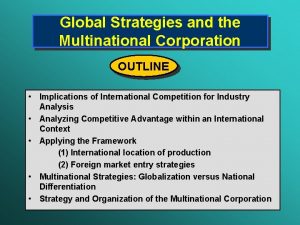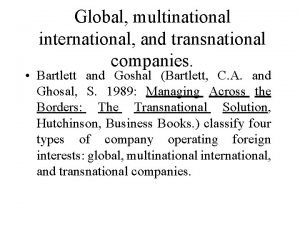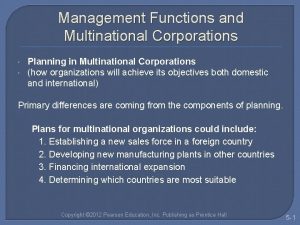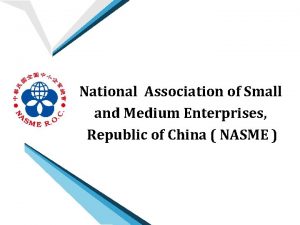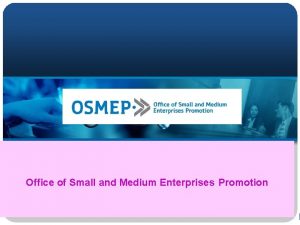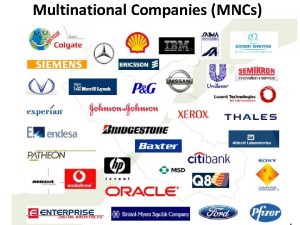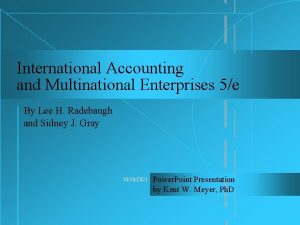International Factor Movements and Multinational Enterprises Chapter 9

















- Slides: 17

International Factor Movements and Multinational Enterprises Chapter 9 Copyright © 2009 South-Western, a division of Cengage Learning. All rights reserved.

Multinational Enterprises MNE Characteristics: o R&D in addition to manufacturing, mining, extractions, and business service o operations across borders o multinational ownership o high ratio of foreign sales to total sales o massive size

Multinational Enterprises (cont. ) o vertical integration – parent company establishes foreign subsidiary for production of intermediate goods or inputs used in the production of final goods o horizontal integration – parent company establishes subsidiary for production of good identical to that produced in the host country o conglomerate integration – parent company established foreign subsidiary for production of unrelated goods o foreign direct investment – acquisition of controlling interest in foreign company or facility

Motives for Foreign Direct Investment o demand factors • tap into foreign markets • expand demand beyond domestic • preemptive measures to prevent foreign competition o cost factors • access to raw materials • lower labor costs • transportation costs especially when representing high percentage of total costs • government policies that grant tax breaks or subsidies for establishing facilities that generate additional domestic employment

Exporting or Foreign Direct Investment If demand in one country is less than 300 but the combined demand is more than 300, the firm could benefit by producing in one location and exporting. However, if the demand in each country is more than 300, the firm could operate two separate facilities without increasing costs.

Foreign Direct Investment or Licensing o establishing a subsidiary entails additional fixed costs o therefore production of 400 units of fewer would face lower costs per unit by licensing to a foreign firm o production of 400 of more units would achieve lower costs by establishing a subsidiary

Country Risk Analysis o political risk: government stability, corruption, domestic conflict, religious & ethnic tensions o financial risk: debt to GDP ratio, loan defaults exchange rate stability o economics risk: growth of GDP, per capita GDP, inflation rate

Japanese Transplants in U. S. Auto Industry Reasons for Japanese direct investment in U. S. : o creates jobs and goodwill o political insurance o avoids potential trade barriers o access to expanding U. S. market o hedge against yen-dollar fluctuations

International Joint Ventures Reasons for joint ventures: o some costs too large for any one company o government restrictions on foreign ownership of local businesses o means of avoiding protectionism against imports

Welfare Effects of Joint Ventures Before Joint Venture o price is $10, 000 because the two firms are competing with each other o $10, 000 ATC because firms cannot achieve economies of scale o only welfare is CS in red

Welfare Effects of Joint Ventures (Cont. ) o with joint venture costs fall because of economies of scale but prices rise because of monopoly o CS decreases o PS increases o welfare loss due to fewer sales o if area ‘d’ is greater than area ‘a’ total welfare increases

MNEs as Source of Conflict o employment • • production facilities create jobs some cases businesses were pre-existing foreign managers maintain executive positions short term job loss in host country o technology transfer • • • demonstration effect – firm shows how products operate competition effect – firm creates superior product could decrease exports if donor nation loses competitiveness o national sovereignty • • impede government attempts to redistribute income evade taxes through pricing strategies

MNEs as Source of Conflict (cont. ) o balance of payments • • • purchase of MNE represents outflow of capital MNE requires capital and equipment from host return inflow of interest, dividends, fees & royalties o taxation • • foreign tax credits – U. S. tax on MNE reduced by the amount of foreign tax by the MNE tax deferrals – tax not paid until income is repatriated o transfer pricing • • goods sold from one division to another within MNE choice of prices impact division of profits and taxes in each area

Labor Mobility - Migration o U. S. immigration - initially more Western Europeans – recently more Mexican and Asian o Immigration Act of 1924 – limited overall flow & established specific quota from each country based on previous emigration patterns o quota formula modified in 1965

Effects of Migration o o labor migration equalizes wages increase in output and welfare in the U. S. decrease in output and welfare in Mexico net gain in world output due to higher VMP in U. S.

Immigration Issues o decreased wages for domestic workers assuming similar skills and productivity o drain on government resources – however within two generations immigrant families assimilate making fiscal burden equal to natives o brain drain – emigration of highly educated limiting growth potential of developing nation o guest workers – granted temporary work permits only – protection against labor shortage or surplus associated with business cycles o illegal immigration concerns o increased contribution to social security

Do Immigrants Hurt U. S. Workers o short run: immigration lowered wages due to increased supply o long run: increased supply lead to more investment in capital increasing demand for labor offsetting initial impact on wages
 International accounting and multinational enterprises
International accounting and multinational enterprises International factor movement
International factor movement List of axial movements
List of axial movements Accounting department workflow
Accounting department workflow Domestic international multinational global transnational
Domestic international multinational global transnational International or multinational
International or multinational Multinational vs transnational
Multinational vs transnational Mnc company definition
Mnc company definition Management and its functions
Management and its functions Form factor formula
Form factor formula Lcm of 12 and 18
Lcm of 12 and 18 Examples of mass movement
Examples of mass movement Risk management for enterprises and individuals
Risk management for enterprises and individuals National association of small and medium enterprises
National association of small and medium enterprises Characteristics of micro enterprise
Characteristics of micro enterprise Bsmepa
Bsmepa Office of small and medium enterprises promotion
Office of small and medium enterprises promotion Multinational cost of capital and capital structure
Multinational cost of capital and capital structure





